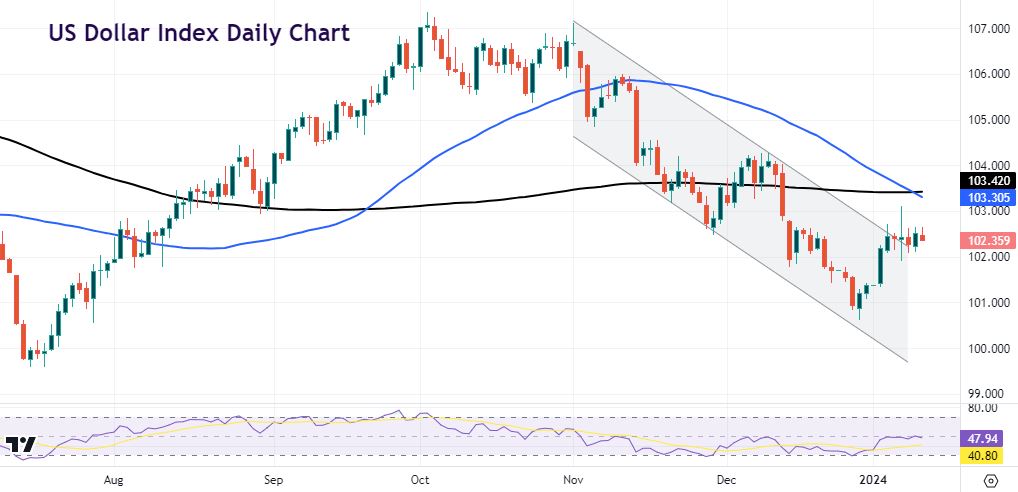FX choppy as markets await US inflation data

Headlines
* US bond markets trim bets on Treasuries ahead of key figures
* US inflation is set to fade in 2024 as goods prices keep falling
* SEC approves spot bitcoin ETF
* Gold extends consolidative phase around $2,300
FX: USD edged lower in, tracking sideways for a sixth straight day. Mild upside in stocks saw some selling but there was little major news. The Fed’s William later in the day said rates are high enough to cool inflation to its goal. But the Fed may have to maintain a restrictive stance for some time.
EUR firmed but stuck to its recent sideways trading pattern between 1.0880 and 1.0998. ECB hawks voiced inflation concerns and that rate cuts were unlikely to come before the summer. This was in contrast to the doves the day before who reaffirmed that policy easing will come this year.
GBP remained above 1.27 with comments from BoE Governor Bailey having minimal market reaction. There has been little demand to push prices up through the high 1.27s. A golden cross has formed on the chart with the 50-day SMA moving above the 200-day SMA. This is regarded as a bullish signal.
USD/JPY surged higher as the yen underperformed its peers. This followed the release of very soft wages data for November which weakened to 0.2% from 1.5% in the previous month. Weaker earnings plus the recent earthquake may add to the BoJ’s cautiousness about exiting NIRP.
AUD was mixed as inflation eased slightly more than expected to 4.3% from 4.9% in November. USD/CAD traded in a very tight range and printed an inside day. Sluggish stock gains are limiting loonie gains but 1.34 is near-term resistance.
Stocks: US equities were in the green as buyers emerged ahead of the big risk event of the week. The S&P 500 added 0.57% to settle at 4,7583. The tech-laden Nasdaq 100 finished 0.69% higher at 16,793. The Dow gained 0.45% to close at 37,696.The recent December high in the benchmark S&P 500 is at 4793, with the index now positive in 2024. The record top set just over two years ago sits 0.3% higher. Earnings season kicks off on Friday with major US financial institutions. Markets will watch what these banks have to say about the health of the economy.
Asian futures are mixed. Stocks mostly dropped on Wednesday after the lacklustre handover from the US. China was subdued with HSBC and Citigroup lowering their Hang Seng index targets due to earnings and China policy doubts. But the Nikkei 225 surged beyond 34,000 for the first time in over three decades as soft wages added to the case for a delayed BoJ exit from ultra-loose policy.
Gold awaited the inflation data as the dollar and yields traded in narrow ranges. The 50-day SMA sits below current prices at $2012.
Day Ahead – US CPI in focus
Today sees the big risk event of the week, US inflation, which is expected to show the headline tick up one-tenth to 3.2% and the monthly at 0.2%. The core is seen at 3.8% y/y and 0.3% m/ for a second straight month. Food and shelter are seen rising while energy prices pose a downside risk. The Fed’s favoured inflation gauge, the core PCE deflator, has been printing lower readings than the CPI over recent months and this is likely to be seen in the consumer basket.
Policymakers seem to be more comfortable with the path of falling prices judging by the recent FOMC minutes. They see risks as “diminished”, which was a key reason for the lower path for the Fed funds rate in 2024. This included an extra 25bps rate cut, so 75bps in total for 2024.
There has been a mild reassessment of the aggressive interest rate cuts expected by markets from the Fed in 2024, starting as soon as March. Those bets have fallen from above 85% a few weeks ago to the current 65%. But while the total number of rate cuts this year has fallen to under six 25bp moves. That means something will have to give compared to the Fed’s projections.
Chart of the Day – USD Index consolidates
Tight trading ranges represent a key characteristic of price action. The longer prices track sideways in narrow ranges, the bigger the breakout and range expansion will eventually take place. This is generally in line with the dominant long-term trend.
The dollar rebound from the multi-month lows in December has taken prices marginally outside of its bear channel. But prices have been trading in a relatively narrow range (aside the NFP spikes) over the last few sessions. A death cross has just taken place which is when the 50-day SMA falls below the long-term 200-day SMA.

